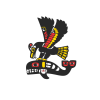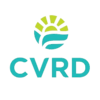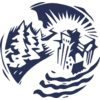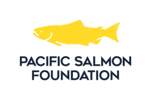The water level in Lake Cowichan is usually above the top of the weir until mid-to-late spring each year. Once the lake level declines, and until lake storage is replenished by fall rains, the lake level and outflow rate can be controlled by the weir. On April 1, generally, the lake becomes "on control", operated with two goals: to prolong lake levels through the late summer and into early fall, and to maintain a flow rate in Cowichan River of 7 cubic metres per second.
Meeting these goals has become increasingly challenging in recent years, due to diminished summer inflows to the lake, and increasing water demands downstream.
The urgency and importance of ensuring that sufficient water is available in the river later in summer relate to:
- the ecological needs of fish, particularly Chinook,
- the economic needs of the community, particularly the Crofton mill, the largest employer in the region and which is unable to operate without water.
Rule Curve
The rule curve, which is in place currently, along with a set of operating guidelines, is operated to ration lake storage and flow rates on a somewhat inflexible basis. As can be seen from the chart to the right, lake levels were below those modelled in the rule curve for three of the five years shown, and occurring as much as two months before the rule curve kicks in. The rule curve achieves less than optimal results, becuase it is not responsive to immediate level and flow conditions.
Rule Band
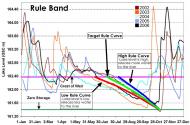 A rule band defines upper and lower limits within which lake levels and discharge rates can be more flexibly managed, matching the curve to actual lake levels.
A rule band defines upper and lower limits within which lake levels and discharge rates can be more flexibly managed, matching the curve to actual lake levels.
By itself, adopting a rule band approach may give only a small benefit to management of lake levels and discharge rates.
Status
The Cowichan Valley Regional District accepted the 2007 Cowichan Basin Water Management Plan with no change to the weir and with no revision of the weir operation rule curve. It did not reject the rule band idea, however, and approved terms of reference for the Cowichan Watershed Board include support for the rule band proposal subject to completion of a LIDAR data gathering program, and fair and timely public consultation.
In order to meet the recommended fish conservation flows year round in the Cowichan River (Objective 3a), the Cowichan Basin Water Management Plan recommended that the weir operation "rule curve" be revised to include an upper and lower bound of managed water levels in the lake (the "rule band") (Objective 2b-1), and that the weir be operated to store spring and summer inflows to the lake, within rule band limits (Objective 2b-2).
In 2013, the BC Ministry of Forests, Lands and Natural Resource Operations, authorized a change to the rule curve, which has given some relief and greater discretion with local flows, but it is insufficient to deal with the reality of hydrological conditions resulting from global warming and climate change (less snow pack, reduced rainfall in summer and especially in late summer, and increased demand by growing human populations and industry.
In 2016, Catalyst Paper obtained permission from the provincial government and put the facilities in place to start pumping water from the lake, under emergency circumstances.
Related Documents
Cowichan Basin Water Management Plan
Westland Resource Group, March 2007
Cowichan Weir Operating Guidelines
Michelle Vessey et al, Catalyst Paper, October 2008
Summer Lake and River Level 2010: What’s Happening?
Craig Sutherland, Presentation, July 2010
Cowichan Lake Water Management Rule Curve & Rule Band
Craig Sutherland, Presentation, January 2011
Cowichan Lake Weir Operation – Rule Curve & Rule Band
Craig Sutherland, Report, January 2011

 Email
Email